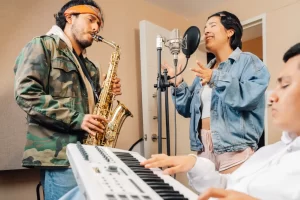The global music industry, like many other sectors, has experienced a seismic shift due to the COVID-19 pandemic. Live performances – the lifeblood of many artists and a significant revenue stream – came to a standstill, pushing the industry to innovate and adapt rapidly. This article aims to explore the emerging trends that have surfaced in the music industry as a result of the pandemic, and how these might shape the sector in a post-COVID world.
We’ll delve into the rise of virtual concerts and the surge in music streaming brought about by global lockdowns. We’ll also discuss the trend towards independent artistry as musicians seek more control over their creative output during these uncertain times. The increased use of social media platforms for music promotion will be another key area of focus, along with changes in music production methods. Each section will provide an in-depth analysis of the trend, its impact on the industry, and potential future implications. As we navigate the new norm, understanding these developments is crucial for anyone involved in the music industry. Get ready to tune into the evolving rhythm of the music business in a post-pandemic world.
Rise of Virtual Concerts and Live Streaming
When the pandemic hit, concert halls and music venues were among the first establishments to close their doors, leaving artists and fans alike yearning for the unique energy of live performances. In response, the industry turned to technology, sparking a massive surge in virtual concerts and live streaming.
Virtual concerts offer an innovative solution that allows musicians to perform from their homes or studios while fans tune in from the safety and comfort of their own homes. These events often incorporate interactive elements, such as live chats and virtual meet-and-greets, to create a sense of community and connection despite the physical distance.
One notable example is the “One World: Together at Home” concert organized by Global Citizen and curated by Lady Gaga in April 2020. This virtual event, which featured performances from artists such as Paul McCartney, Elton John, and Billie Eilish, was watched by millions of viewers around the world and raised over $127 million for the World Health Organization’s COVID-19 Solidarity Response Fund.
Live streaming has also seen a significant boost, with platforms like Twitch, YouTube, and Instagram Live becoming popular choices for musicians to connect with their audiences. According to a report from MRC Data and Billboard, 60% of consumers in the U.S. increased their consumption of live-streamed content during the pandemic.
This shift towards virtual concerts and live streaming has not only provided a lifeline for the music industry during lockdowns but also opened up new opportunities. Artists can now reach global audiences without the constraints of geography, and fans have unprecedented access to their favorite musicians. While nothing can truly replace the magic of live, in-person performances, the rise of these digital platforms suggests that virtual concerts and live streaming will continue to play a significant role in the music industry post-pandemic.
Surge in Music Streaming Consumption
As the world went into lockdown and people spent more time at home, there was a significant increase in music streaming. According to Nielsen Music/MRC Data, on-demand streaming numbers reached an unprecedented high in 2020, with over 1 trillion streams in the U.S. alone.
This trend was fueled by several factors. People sought comfort, distraction, and connection through music during these trying times. Furthermore, the rise of working from home meant that individuals could curate their own soundtracks for the day, leading to increased music consumption.
For artists, this surge presented a double-edged sword. On one hand, it offered an opportunity to reach wider audiences. On the other hand, the financial realities of streaming revenues remained a challenge. Streaming platforms typically pay artists a fraction of a penny per stream, making it difficult for many musicians to earn a sustainable income from streaming alone.
Despite these challenges, the spike in streaming consumption signifies a potential shift in how listeners engage with music. As we move towards a post-COVID era, it will be interesting to see if this trend continues, shaping the future of music distribution and consumption.
Shift Towards Independent Artistry
The music industry has historically been dominated by major record labels, but the pandemic has accelerated a shift towards independent artistry. With live shows and tours cancelled, many artists have had to rethink their approach to making and releasing music. This has led to an increased focus on independent production and distribution, as artists seek more control over their work.
In the past, signing with a major label was often seen as the only path to success. However, the rise of digital platforms has democratized music distribution, making it possible for artists to reach global audiences without the need for a traditional record deal.
This shift towards independence has also been driven by financial considerations. With streaming revenues often falling short, artists are seeking ways to maximize their income. By releasing music independently, they’re able to retain a larger share of the profits.
While being an independent artist comes with its own set of challenges, it also offers greater creative freedom. It’s likely that this trend towards independent artistry will continue to shape the music industry.
Increased Use of Social Media for Music Promotion
The pandemic has transformed social media from a supplementary promotional tool to a primary platform for music artists. As live events were cancelled and people turned to their screens for entertainment, musicians began leveraging social media platforms to connect with fans, promote new releases, and even perform live.
Platforms like Instagram, Facebook, and Twitter have become essential tools for artists to share updates and engage with their audience. Instagram Live, in particular, has emerged as a popular choice for virtual performances, while Twitter’s real-time nature makes it ideal for announcements and fan interactions.
Meanwhile, TikTok has revolutionized music promotion with its viral trends and challenges. The platform’s algorithm promotes discovery, allowing songs – old and new – to gain sudden popularity. An example is Fleetwood Mac’s “Dreams,” which saw a resurgence after being featured in a viral TikTok video.
Moreover, social media allows artists to control their narrative and build their brand on their terms. They can share behind-the-scenes content, sneak peeks of new projects, and personal insights, creating a more intimate connection with fans.
Social media remains a vital part of music promotion, with artists continuing to explore innovative ways to use these platforms to reach their audiences.
Changes in Music Production
The pandemic has had a profound impact on music production, leading to innovative adaptations and a shift towards remote collaboration. With studios closing and social distancing measures in place, artists and producers have had to rethink traditional recording processes.
Home studios have become the new norm, with artists recording parts in their own spaces and sending files digitally for mixing and mastering. This has democratized music production, making it more accessible to artists who may not have had resources to book professional studio time.
Remote collaboration tools have also gained prominence. Platforms like Soundtrap and Splice allow multiple users to work on the same project simultaneously, regardless of their location. This has opened up opportunities for international collaborations, bringing together artists who might never have been able to work together in a traditional studio environment.
Moreover, the constraints of lockdown have inspired creativity and experimentation. Some artists have incorporated ambient sounds from their homes into their tracks, while others have explored new genres and styles.
While these changes were born out of necessity, they’re likely to persist. The future of music production could be increasingly digital, decentralized, and collaborative, shaping a new era of musical innovation.
To Sum It Up
The pandemic has undeniably disrupted the music industry, but it has also sparked a period of rapid evolution and innovation. The shift towards independent artistry, increased use of social media for music promotion, and changes in music production are all indicative of an industry adapting to new realities.
Independent artists are now in an empowered position, with digital platforms providing access to global audiences while retaining creative control and a larger share of profits. Social media has become a primary platform for music promotion, allowing artists to engage with fans, perform live, and even achieve viral fame.
Music production has also been revolutionized, with home studios and remote collaboration tools enabling artists to work together from different locations. This not only democratizes music production, but also encourages international collaborations and creative experimentation.
While these changes were initially driven by necessity, they have the potential to reshape the music industry in the long term. It’s clear that the music industry will continue to evolve, driven by technological advancements and changing artist needs. The future of music is likely to be more digital, decentralized, and artist-centric than ever before.




